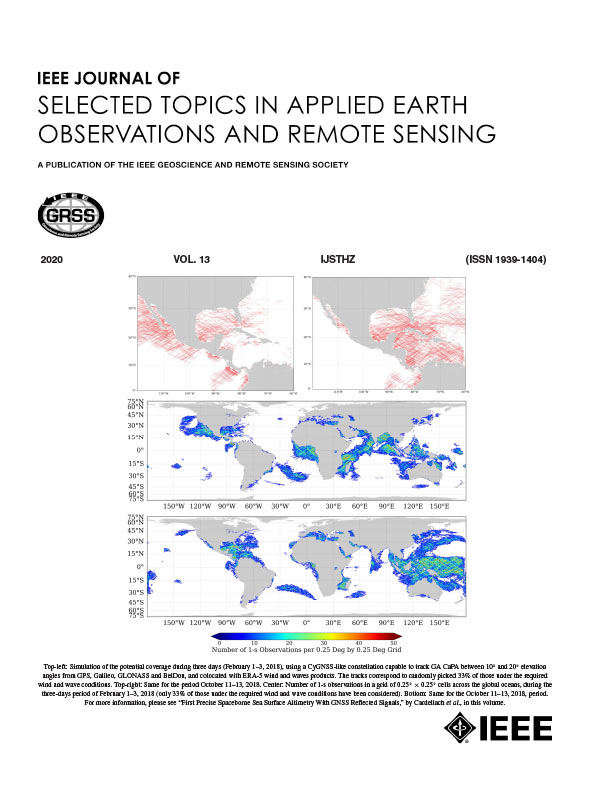利用 SMAP 卫星观测数据进行土壤水分遥感的反动态参数识别
IF 4.7
2区 地球科学
Q1 ENGINEERING, ELECTRICAL & ELECTRONIC
IEEE Journal of Selected Topics in Applied Earth Observations and Remote Sensing
Pub Date : 2024-09-10
DOI:10.1109/JSTARS.2024.3457941
引用次数: 0
摘要
在土壤水分主动被动(SMAP)任务的土壤水分检索算法中,表面粗糙度和植被散射对亮度温度的影响传统上使用时间不变参数建模:粗糙度强度(h)和有效散射反照率(ω)。这种简化忽略了 h 和 ω 随时间的变化,可能会影响卫星足迹尺度上土壤湿度估算的准确性。本研究旨在专门为 SMAP 单信道算法(SCA)和正则化双信道算法(RDCA)推导动态的像素尺度 h 和 ω 参数。这是通过迭代反演程序实现的,该程序最大限度地减小了具有空间代表性的 9 千米土壤湿度模拟亮度温度与 SMAP 核心验证站点观测数据之间的差异。结果表明,纳入按日尺度得出的动态 h 和 ω 参数后,土壤水分检索性能明显提高,SCA(RDCA)算法的平均无偏均方根误差(ubRMSE)为 0.01(0.02)立方米/立方米,皮尔逊相关性(R)为 0.95(0.90),表明动态参数化在提高检索精度方面大有可为。日尺度 h 参数一般高于 SMAP SCA 中使用的静态值。在 SMAP SCA 框架内,采用从 SCA 范围(h∊ [0.03, 0.16] 和 ω∊ [0, 0.08])中随机选择的日尺度 h 和 ω 参数估算的土壤水分精度显示出显著的稳定性,可与 SMAP 第 3 级产品相媲美。此外,还对日尺度参数进行了时间收缩,以生成 h 和 ω 的月气候。虽然根据这些气候学 h 和 ω 参数得出的土壤水分值的绝对偏差有所减小,但其 ubRMSE 和 R 与 SMAP 第 3 级产品相比略有下降。这种下降可能表明,气候参数的渐变不足以捕捉这些日参数的波动。此外,RDCA 的静态 h 和 ω 值系统地高于 SCA。然而,不同算法的动态 h 和 ω 值没有一致的趋势。要在 SMAP 算法框架内确定最有效的动态 h 和 ω 参数,不仅需要选择适当的参数范围,还需要准确跟踪地表粗糙度和植被散射的时间演变。土壤湿度检索的改进可能带来的应用包括农田管理及其生产力预测、地表全球水和能量通量的量化以及森林管理,特别是在干旱、洪水或野火等干扰情况下。本文章由计算机程序翻译,如有差异,请以英文原文为准。
Inverse Dynamic Parameter Identification for Remote Sensing of Soil Moisture From SMAP Satellite Observations
In the soil moisture active passive (SMAP) mission's soil moisture retrieval algorithms, the effects of surface roughness and vegetation scattering on the brightness temperature are conventionally modeled using time-invariant parameters: roughness intensity (
h
) and effective scattering albedo (ω). Such simplification neglects the variability of
h
and ω over time, potentially compromising the accuracy of soil moisture estimates at the satellite footprint scale. This study aims to derive dynamic, pixel-scale
h
and ω parameters specifically for the SMAP single-channel algorithm (SCA) and the regularized dual-channel algorithm (RDCA). This is achieved through an iterative inverse procedure that minimizes the differences between the simulated brightness temperatures from spatially representative 9 km soil moisture and SMAP observations across the SMAP core validation sites. The results demonstrated that the incorporation of dynamic
h
and ω parameters, derived on a daily scale, markedly enhanced the soil moisture retrieval performance with an average unbiased root-mean-square error (ubRMSE) of 0.01 (0.02) m
3
/m
3
and Pearson correlation (
R
) of 0.95 (0.90) for the SCA (RDCA) algorithms, indicating that dynamic parameterization holds significant promise for improving retrieval accuracy. The daily scale
h
parameters are generally above the static values utilized in the SMAP SCA. Within the SMAP SCA framework, the accuracy of soil moisture estimates employing daily scale
h
and ω parameters—randomly selected from the SCA range (
h
∊ [0.03, 0.16] and ω∊ [0, 0.08])—demonstrates notable stability and is comparable with the SMAP level 3 product. Furthermore, the daily scale parameters were temporally contracted to generate a monthly climatology for
h
and ω. While soil moisture values derived from these climatological
h
and ω parameters exhibit reduced absolute bias, their ubRMSE and
R
slightly degrade relative to SMAP level 3 product. This degradation likely suggests that the climatological parameters’ gradual variations are insufficient to capture the fluctuations of those daily parameters. Moreover, the static
h
and ω values for the RDCA are systematically higher than those for the SCA. However, there is no consistent trend in the magnitudes of dynamic
h
and ω between different algorithms. Identifying the most effective dynamic
h
and ω parameters within the SMAP algorithmic framework necessitates not only selecting an appropriate parameter range but also accurately tracking the temporal evolutions of surface roughness and vegetation scattering. Potential applications arising from improvements in retrieved soil moisture include the management of agricultural lands and forecasts of their productivity, quantification of global water and energy fluxes at the land surface, and management of forests, particularly in instances where disturbances, such as droughts, floods, or wildfire, are concerned.
求助全文
通过发布文献求助,成功后即可免费获取论文全文。
去求助
来源期刊
CiteScore
9.30
自引率
10.90%
发文量
563
审稿时长
4.7 months
期刊介绍:
The IEEE Journal of Selected Topics in Applied Earth Observations and Remote Sensing addresses the growing field of applications in Earth observations and remote sensing, and also provides a venue for the rapidly expanding special issues that are being sponsored by the IEEE Geosciences and Remote Sensing Society. The journal draws upon the experience of the highly successful “IEEE Transactions on Geoscience and Remote Sensing” and provide a complementary medium for the wide range of topics in applied earth observations. The ‘Applications’ areas encompasses the societal benefit areas of the Global Earth Observations Systems of Systems (GEOSS) program. Through deliberations over two years, ministers from 50 countries agreed to identify nine areas where Earth observation could positively impact the quality of life and health of their respective countries. Some of these are areas not traditionally addressed in the IEEE context. These include biodiversity, health and climate. Yet it is the skill sets of IEEE members, in areas such as observations, communications, computers, signal processing, standards and ocean engineering, that form the technical underpinnings of GEOSS. Thus, the Journal attracts a broad range of interests that serves both present members in new ways and expands the IEEE visibility into new areas.

 求助内容:
求助内容: 应助结果提醒方式:
应助结果提醒方式:


